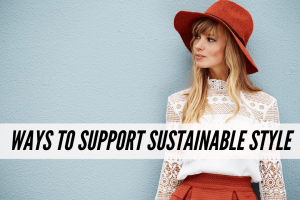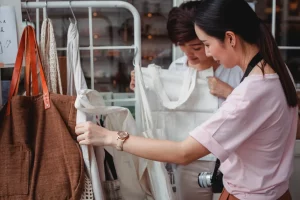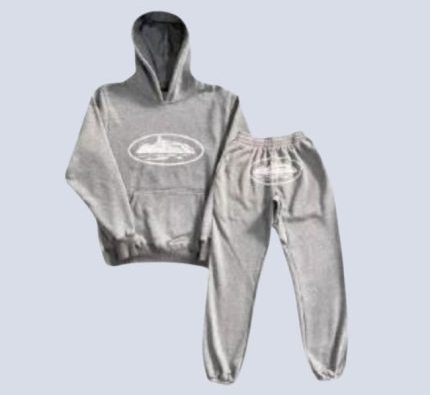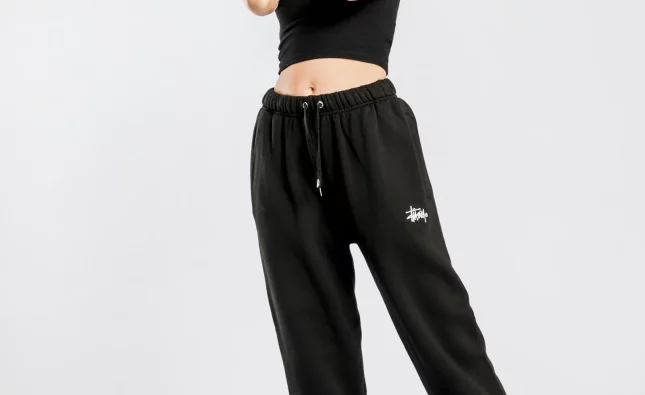
Introduction
The fashion industry is one of the largest polluters in the world, contributing to environmental degradation, water waste, and unethical labor practices. But it doesn’t have to be this way. By making mindful choices and supporting sustainable fashion, you can help reduce your environmental impact and promote ethical practices in the industry. Sustainable fashion isn’t just a trend—it’s a movement towards a more conscious and eco-friendly way of dressing. Whether you’re new to sustainable fashion or looking for more ways to make a difference, there are plenty of simple, effective steps you can take. In this article, we’ll explore practical tips to help you support sustainable fashion, from choosing eco-friendly brands to caring for your clothes in ways that extend their life. Ready to make your wardrobe more sustainable and stylish? Let’s dive in.
What is Sustainable Fashion?

Sustainable fashion means choosing clothes that are made in a way that’s better for the planet and people. This involves thinking about how clothes are made, what materials are used, and how the workers are treated. Sustainable fashion aims to reduce waste, pollution, and support fair working conditions.
Key aspects of sustainable fashion include:
- Ethical practices: Fair treatment for workers and good working conditions.
- Eco-friendly materials: Fabrics that don’t harm the environment.
- Durability: Clothes that last longer so you don’t need to keep buying new ones.
- Recycling: Using old clothes to make new ones instead of throwing them away.
Supporting sustainable fashion helps make sure the planet and its people are treated fairly.
Tips How to Support Sustainable Fashion

1. Choose Quality Over Quantity
Investing in high-quality, durable clothing reduces waste and promotes a more sustainable wardrobe.
Tip: Look for well-made pieces that can withstand regular wear and last for years.
Example: “I started buying fewer but higher-quality items, and I noticed my clothes lasted much longer and looked better over time.”
2. Support Ethical and Eco-Friendly Brands
Research and support brands that prioritize sustainable materials, ethical labor practices, and transparent supply chains.
Tip: Look for certifications like Fair Trade, GOTS (Global Organic Textile Standard), or B Corp.
Example: “Switching to eco-friendly brands like Patagonia and Everlane made me feel good about where my money was going.”
3. Embrace Secondhand and Thrift Shopping
Buying secondhand reduces waste and extends the life of clothing that might otherwise end up in landfills.
Tip: Explore thrift stores, online resale platforms, and vintage shops for unique, sustainable finds.
Example: “I found a designer jacket at a thrift store for a fraction of the price it’s now my favorite piece!”
4. Rent or Borrow Special Occasion Outfits
Instead of buying new clothes for one-time events, consider renting or borrowing to reduce waste.
Tip: Use clothing rental services like Rent the Runway or borrow from friends for special occasions.
Example: “I rented a gown for a wedding, saving money and avoiding a dress I’d only wear once.”
5. Care for Your Clothes Properly
Proper care extends the life of your clothing and reduces the need for frequent replacements.
Tip: Wash clothes in cold water, air dry when possible, and avoid over-washing.
Example: “I started air-drying my clothes and noticed they stayed in better condition longer.”
6. Upcycle and Repurpose Old Clothing
Give new life to old clothes by upcycling, repairing, or repurposing them into something fresh and unique.
Tip: Learn basic sewing skills to repair small tears or transform outdated pieces.
Example: “I turned an old pair of jeans into a stylish denim tote bag, giving it a second life.”
7. Mind Your Laundry Habits
Laundry habits can significantly impact the environment. Washing less frequently and using eco-friendly detergents helps reduce water and energy use.
Tip: Use a microfiber filter to prevent microplastics from entering waterways.
Example: “Switching to eco-friendly detergent and washing less often reduced my environmental footprint.”
8. Educate Yourself and Spread Awareness
Staying informed about the fashion industry’s impact and sharing knowledge with others promotes a wider shift toward sustainable fashion.
Tip: Follow sustainable fashion influencers, read articles, and support campaigns that advocate for ethical practices.
Example: “After learning about fast fashion’s impact, I shared resources with friends, and we started hosting clothing swaps together.”
Importance of Choosing Eco-Friendly Materials

Choosing eco-friendly materials is an important part of supporting sustainable fashion. Traditional fabrics like polyester and nylon are made from petroleum-based resources and can take hundreds of years to decompose in landfills. On the other hand, eco-friendly materials such as organic cotton, bamboo, and hemp are grown without harmful chemicals and have a smaller impact on the environment. By opting for clothes made from these materials, you help reduce pollution and conserve natural resources, making a positive difference for the planet.
Supporting Ethical Brands
When you choose to shop from ethical brands, you’re supporting companies that care about the workers who make the clothes. Many fast fashion brands exploit workers, paying them low wages and subjecting them to unsafe working conditions. Ethical brands, however, focus on fair wages, safe working environments, and workers’ rights. By supporting these brands, you help create a more just and fair fashion industry where workers are treated with dignity and respect.
The Role of Secondhand and Vintage Shopping

Secondhand shopping has become a popular way to reduce waste in the fashion industry. When you buy secondhand clothes, you give them a second life instead of contributing to landfill waste. Vintage shops and online secondhand stores offer unique and affordable clothing options, allowing you to find special items that you might not find in regular stores. Not only is this great for the environment, but it also helps promote a culture of reusing and recycling, which is essential for a more sustainable fashion future.
The Power of Repairing Clothes
Instead of throwing away clothes that have a small tear or are slightly worn out, consider repairing them. Many garments can be mended with a bit of stitching, or you can take them to a tailor to be fixed. Repairing clothes helps reduce the need for new purchases and extends the life of your wardrobe. By learning how to repair your clothes or finding local repair shops, you help keep clothes out of landfills and contribute to a more sustainable lifestyle.
Reducing the Need for Fast Fashion

One of the main issues with the fashion industry is the rise of fast fashion, where clothes are made quickly and cheaply, leading to overconsumption and waste. By purchasing fewer, high-quality items, you can avoid the cycle of buying trendy clothes that you only wear a few times. Focus on classic pieces that never go out of style and can be worn for years. This reduces the demand for cheap, mass-produced clothing and encourages brands to prioritize quality and sustainability over speed and volume.
Educating Yourself and Others
A key part of supporting sustainable fashion is learning about the impact of the fashion industry and sharing this knowledge with others. The more people understand the importance of eco-friendly clothing, ethical production, and sustainable shopping habits, the more likely they are to make better choices. You can educate yourself by researching brands, materials, and sustainable practices, and you can spread the word by talking to friends and family. Together, we can create a culture that values sustainability in fashion and beyond.
Challenges of Sustainable Fashion
Despite its benefits, sustainable fashion faces challenges. One major issue is the higher cost of eco-friendly materials and ethical production practices. Clothes made with sustainable materials often cost more to produce, which can make them more expensive for consumers. Additionally, the fashion industry is vast, and making it more sustainable requires a big shift in how things are done, from manufacturing to shipping. There’s also the challenge of educating consumers about the importance of sustainability and making it easier for them to access sustainable options.
Future of Sustainable Fashion

The future of sustainable fashion looks promising, with more people and brands embracing it. As technology improves, it will become easier to create sustainable fabrics and reduce waste in production. The rise of secondhand shopping and clothing recycling is also helping reduce the impact of fashion. In the future, we can expect more brands to adopt eco-friendly practices and offer more affordable sustainable options. As consumers continue to demand change, the fashion industry will likely become more environmentally conscious and socially responsible.
Analysis Table: Sustainable Fashion Choices
| Sustainable Choice | Environmental Benefit | Social Benefit | Cost |
|---|---|---|---|
| Eco-friendly materials | Less pollution, water, and energy use | Supports responsible production | Higher upfront cost |
| Ethical fashion choices | Supports fair labor, reduces exploitation | Fair wages and better working conditions | Varies by brand |
| Sustainable manufacturing | Reduces water waste, uses less energy | Supports ethical and fair practices | Often more expensive |
| Quality over quantity | Less waste, fewer replacements needed | Promotes mindful consumption | Higher initial cost |
| Secondhand shopping | Reduces landfill waste, lower carbon impact | Supports local communities, affordable options | Lower cost, often cheaper |
| Proper clothing care | Extends the life of clothing | No direct social benefit | Low cost, maintenance-based |
| Recycling and upcycling | Keeps clothes out of landfills | Helps give clothes a second life | Low or no cost |
Comparison Table: Sustainable Fashion vs. Fast Fashion
| Aspect | Sustainable Fashion | Fast Fashion |
|---|---|---|
| Environmental Impact | Lower pollution, uses fewer resources | High pollution, large carbon footprint |
| Labor Conditions | Fair wages and safe working conditions | Often poor working conditions, low wages |
| Quality | Durable, long-lasting clothes | Low-quality, disposable clothing |
| Waste | Less waste, focuses on recycling and upcycling | High waste, thrown away after a short period |
| Cost | Higher upfront, longer-lasting value | Cheaper, but wears out quickly |
| Consumption | Focuses on mindful, minimal purchases | Encourages excessive buying and consumption |
Conclusion
Supporting sustainable fashion isn’t just about changing the way you shop it’s about making thoughtful choices that align with your values. By prioritizing quality over quantity, supporting ethical brands, and embracing secondhand shopping, you can make a meaningful difference in reducing waste and promoting eco-friendly practices. Every small step counts, whether it’s caring for your clothes, renting instead of buying, or simply being more mindful of your consumption. Remember, sustainable fashion is about progress, not perfection. Together, we can create a more conscious, ethical, and stylish future. Ready to transform your wardrobe and make a positive impact on the planet? Start today, and let your fashion choices reflect the change you want to see.
Call to Action
What are your favorite ways to support sustainable fashion? Share your tips and experiences in the comments below, and subscribe for more eco-friendly living and ethical fashion guides!










